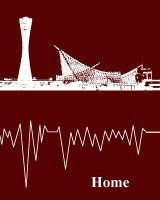
![]() Download - General Information [PDF 404kb] as of Oct. 12.
Download - General Information [PDF 404kb] as of Oct. 12.
About Kobe City
Kobe is one of Japan's oldest port and international trading cities. Nestled between sea and mountain it enjoys gentle breezes from the Seto Inland Sea while pure waters flow down from Nunobiki Waterfalls and the Mt. Rokko behind.
As such, this historical, yet ultra-modern, city is surrounded by lush greenery and natural splendor. The bounty of this is apparent in Kobe's traditional sake, local wines, and world-renowned ‘Kobe Beef'.
In the mountains there are outdoor facilities, herb gardens and hiking routes - all just a cable-car ride away - and the night views are spectacular. Bay cruises offer pleasant alternatives to dining downtown and another way to enjoy night-time city lights.
Japanese travelers visit Kobe to enjoy, in particular, the wide range of downtown epicurean delights (Kobe is known for its confectionary and China Town food alleys) as well as fashion boutiques, arcades and shopping emporia.
International visitors also enjoy the amazing architectural structures, such as the Akashi Bridge, and the old-town atmosphere of the Arima spa resort nestled in the mountains.
Being located almost in the center in Japan, Kobe has nearly all the must-see World Heritage sights and cities within easy reach. Less than an hour away, to the west, is Hiroshima Peace Park and, on the way, you can visit magnificent Himeji Castle or the canals of Kurashiki. Day trips eastwards to Kyoto (25 minutes) and Nara are home to Japan's most representative temples and shrines. For thrill-seekers, the world-class theme park at Universal Studios Japan is just 30 minutes away while, downtown, art galleries can offer a more relaxed experience. Kobe has something for all – the outdoor sporting type, the shopper, the food aficionado, the historian and culture-seeker.
For general information on Japan and Kobe, please visit:
-The JNTO (Japan National Tourism Organization) website at: http://www.jnto.go.jp/
-The Kobe Convention & Visitors Association website: http://www.feel-kobe.jp/english/
Climate and Clothing
The weather in Japan during the Congress period, late October, is usually warm during the day and cool at night.
The average October temperature in Kobe is 19.5 deg. Celsius (67.1 deg. F), although there is about 4 degrees difference between Kobe's downtown (sea level) and the heights of Mt. Rokko. Lightweight jackets and sweaters will be comfortable for this season. All of the city's hotels and facilities, including the Congress venues, are fully air-conditioned.
Shopping
A variety of shopping opportunities can be found in Kobe.
Kobe's historic shopping area, known as Moto-machi, extends west for 2 km from JR Moto-machi Station. Much of the district is under a covered arcade, which starts opposite the Daimaru department store and runs just north of Nankin-machi (China Town).
Moto-machi is more of a functional shopping area, selling housewares (including antiques), imported foods, and electronics, with restaurants scattered between.
Currency Exchange
It is recommended that participants purchase Japanese yen traveler's checks prior to leaving their own countries.
Exchange of major currencies is available at most banks, airports and large hotels.
Electricity
Although 100 volts is the standard power supply throughout Japan, there is a small regional difference relating to cycles (Kobe and Western Japan = 60Hz, Tokyo and Eastern Japan = 50Hz).
Most hotels are equipped with 110v outlets, and you may require an adapter for the ungrounded (2-pin) North American outlets.
Internet
Many hotels in Kobe provide complimentary high-speed internet access. Wireless connectivity is available on most levels of the International Conference Center.
Insurance
Registration fees do not include the insurance of participants against personal accidents, sickness, cancellations (by any party), theft, loss or damage to personal possessions.
Participants are advised to take out adequate personal insurance to cover travel, accommodation, cancellation and personal effects.
Transportation
Kobe is easily accessible by road, rail and air. Most delegates will likely stay in hotels next to the Congress venues (center of Port Island) or in downtown Kobe (called Sannomiya).
Port Island and downtown Kobe are about 10-15 minutes away by road or monorail.
Kansai International Airport (KIX) is likely to be the main port of entry for most international delegates.
From KIX airport, delegates can take one of the frequent Airport Limousine Buses directly to downtown Kobe (Sannomiya).
This is a fast coastal road and takes 70 minutes. Alternatively, a bay shuttle ferry (every 50 minutes) provides a transfer in approx. 30 minutes to a docking harbor about 10 minutes away from the Port Island.
There are various options for traveling down to Kobe from Tokyo if delegates arrive at Narita International Airport.
These include:
-Shinkansen (bullet) train from Tokyo Station (approx. 2 hours 50 minutes)
-Domestic flight (80 minutes) from Tokyo Haneda to Kobe Airport (close to Port Island)
-Domestic flight (70 minutes) from Narita (or Haneda) to Osaka Itami Airport


